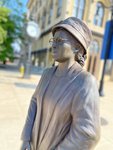



MONTGOMERY, Alabama — The birthplace of both the Civil Rights movement and the Confederacy feels smaller than any other capital city I’ve visited.
None, though, loom larger when it comes to historical significance.
Park yourself at just about any spot along Dexter Avenue, the wide lane sloping gently down from the capitol building toward the heart of Montgomery’s downtown, and with a good arm and a baseball you can hit nearly a dozen landmark locations from a critical 150-year period of Southern — and American — history.
There’s the Alabama state capitol itself. Jefferson Davis took his oath there as president of the Confederate States of America; a century later, staunch segregationist and four-term governor George Wallace planted his feet on the same steps and declared, famously, “segregation now, segregation tomorrow, segregation forever.”
Not far away is the first White House of the Confederacy.
And there’s Dexter Avenue Baptist Church, where an unknown 26-year-old pastor, hailing from Atlanta, would be asked to become the voice for the city’s disenfranchised.
There’s a statue of the diminutive Rosa Parks not far from the spot where she declined — politely, with dignity, and with a larger aim in mind — to give up her seat on a city bus, defying the same vituperative driver who’d had her arrested a dozen years before and igniting a firestorm.
Dozens of slave traders once had offices along the street. Nearly 60 markers dedicated to the architects of Alabama’s and Montgomery’s mass slave trade have been erected around town over the years. Today, you can also see the Civil Rights Memorial Center, the Southern Poverty Law Center, a museum devoted to the Freedom Riders, and the home where that young Dexter Avenue Baptist Church pastor, Dr. Martin Luther King Jr., lived.
And you end right back on the steps of the capitol — the destination for a determined group of rabble-rousers who, in the spring of 1965, would leave from Selma, some 55 miles west via a meandering two-lane road, on a walk that would change history.
I spent a few days in Montgomery last week. Some 50 or 60 of us were supposed to have made this journey by bus in the fall of 2020. But COVID-19 prompted a series of postponements; after coronavirus concerns canceled the bus, our group shrank to a dozen or so — mostly members of the Community Remembrance Coalition-Chatham and some friends and relatives.
The CRC-C has been working to, among other things, recognize Chatham’s lynching victims in a partnership project with the nonprofit Equal Justice Initiative, based in Montgomery. My wife Lee Ann and I drove from North Carolina and joined the group for tours of the EJI’s two groundbreaking public efforts: The Legacy Museum and the National Memorial for Peace and Justice.
The Legacy Museum is designed as a “narrative museum,” purposed, in the words of EJI founder Bryan Stevenson, to “confront our nation’s silence and to change the distorted narrative that too many have been taught.” It focuses on the history and legacy of slavery and abuse against African and African American people.
“The enslavement of black people has created a legacy of separation, inequality, and anguish that will persist until we address that legacy more honestly,” Stevenson writes.
The story of that two-centuries legacy is told in clear and unmistakably stark ways at the Legacy Museum. The three hours we spent was barely enough time to understand how the elaborate narrative of racial inferiority shaped our country.
“The way to right wrongs,” crusading writer Ida B. Wells said, “is to turn the light of truth upon them.” And that truth is beginning in the late 1700s, more than 12 million African men, women and children were kidnapped and sold into slavery in the Americas.
In Montgomery, for example, just prior to the Civil War, two-thirds of its residents were enslaved.
That labor led to the creation of generations of wealth for thousands of families across the South and elsewhere, but the abolishment of chattel slavery — with the passage of the 13th Amendment — did little to change the dehumanization of Black Americans.
The 12-year period of Reconstruction after the Civil War helped to re-establish white supremacy in the South. “Free” Black people continued to be refugees in their own country; at least 4,000 were lynched in racial terror killings in a dozen states between 1880 and 1940, including 120 in North Carolina and six here in Chatham. Segregation, bigotry and injustice were prevalent; mass incarceration and poverty became persistent by-products that are still with us.
It’s a well-evidenced truth some deny or downplay. Even as knowledgeable as I felt I was about that legacy, what I saw, heard and learned in that brief museum visit — an experience difficult to encapsulate or summarize in words — brought me to my knees.
We next visited the Memorial, situated upon the crest of a hill and overlooking downtown Montgomery about a mile from the museum. It occupies six acres of outdoor space and includes spectacular gardens, sculpture, poetry and more.
It effectively contextualizes racial terror, primarily with more than 800 suspended six-foot corten steel monuments. Each represents a geographic location (typically a county) where lynchings occurred and contains the names of victims and dates of those acts of terrorism. There are also stories of those murdered, the paper-thin — if not outright mendacious — rationalization for killing that, even for the heyday of white supremacy, boggles any rational mind.
From the Memorial, we crossed the street to the Peace and Justice Memorial Center, a gathering place for educational events. There, we finished the day meeting with Laurel Hattix, an EJI Law Fellow, who shared the EJI story and answered our questions about EJI’s work and plans.
Our group solemnly disbanded the next morning. Lee Ann and I spent part of the day in Selma; the former cotton trading center some 55 miles west of Montgomery is now one of the poorest cities in the country. Jim Crow and segregation ruled for a century until “Bloody Sunday” in 1965 — which led to an unimpeded march two weeks later ending with 25,000 people entering Montgomery to protest the lack of voting rights for Black Americans — sparked more change. That led to the passage of the Voting Rights Act of 1965, which provided federal oversight and enforcement of already-given constitutional rights for all Americans.
Like John Lewis and other 1965 activists, leaders and score of volunteers and supporters of equality and justice, we walked across the Edmund Pettus Bridge in Selma. When we finally left, we made it back to Montgomery in less than an hour — not five days, like Lewis and MLK and hundreds of others. But like Lewis, change was a part of our journey.
Later that night, we found ourselves once again near the steps of the capitol. A few years after he was left paralyzed from the waist down in an assassination attempt, George Wallace was saved. He announced he’d become a born-again Christian; he made numerous public and personal apologies about his beliefs and his actions from earlier in his life.
“I was wrong,” Wallace said. “Those days are over, and they ought to be over.”
Once, power and glory were Wallace’s goals. With his change of heart, he realized what he really needed was love and forgiveness.
Traveling to Montgomery, despite its history, wasn’t a trip back in time. Rather, it was a reminder that, indeed, some things ought to be over — and the power that results from a change of heart.
Bill Horner III can be reached at bhorner3@chathamnr.com or @billthethird.